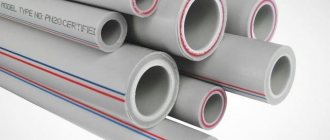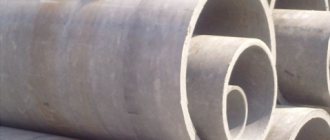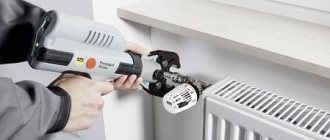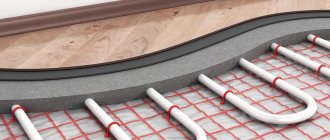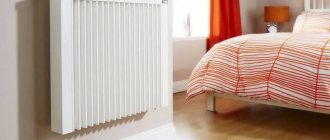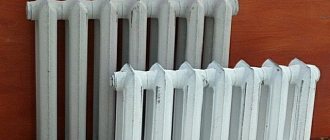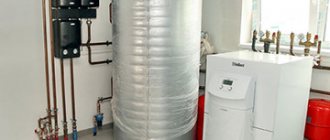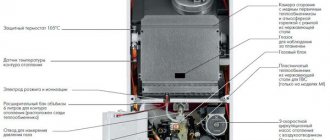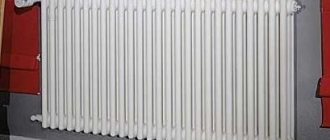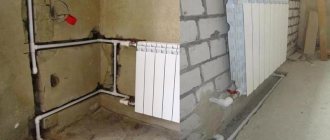Any type of pipe will be good when it is in its place. The question of which pipes are better for heating will probably always remain relevant. Pipes for heating systems can be of the following types:
- Copper pipes;
- Stainless steel pipes;
- Plastic pipes;
- Steel pipes;
- Metal-plastic pipes.
Let's figure out which heating pipe is right for you, which heating pipes to choose will be the best option.
For installation of a heating system, you can choose pipes from various materials.
Steel pipes for heating system
Modern steel heating pipes have been used to organize heating systems for decades. Their good performance characteristics are time-tested. Craftsmen value pipes made from this material because they have a long service life and are considered quite reliable. Such pipes are able to withstand very high temperatures and fairly high operating pressure.
When you think about which pipes are best for heating, you should remember that a heating system made from steel pipes is quite reliable, but at the same time, it does not belong to the cheap category and is not entirely technologically advanced.
Such pipes are not very easy to hide from view, so they do not evoke positive emotions among designers. Another disadvantage of steel pipes is the fact that only an experienced welder can install the heating system.
Steel pipes for heating system
Types of steel heating pipes are justified if they are used where high strength or large diameters are required. Also, as an option, such pipes will be a good solution if you need to replace old iron pipes in your apartment.
What pipes are used for heating
The choice of materials is not so wide - metals (black steel and galvanized copper) and reinforced polymers - polyethylene, polypropylene. That's basically it. But recently a new product has appeared on the market - corrugated stainless steel, which is inexpensive, has high performance characteristics, and is also easy to install. True, the operating experience is still very small - it’s a new product, but all the reviews that exist are positive.
Steel pipes
If we talk only about pipes, then this is the cheapest option. But welding plays an important role in the cost of the system: the services of a good welder are not cheap (and a bad one is not needed) - few people ask for less than 15 thousand for assembling an average system. rub. So, as a result, it's not that cheap.
In addition to the low price for the material, the advantages of steel pipes include high resistance to temperature and pressure changes, low thermal expansion, as well as mechanical strength: to damage them you will need tools and remarkable strength.
High heat transfer can be attributed to both pros and cons. If steel pipes are installed inside a heated room, then such heat losses are, in principle, not dangerous - the heat remains in the room. And if the pipes go through an unheated room (basement, attic, etc.), then they require careful thermal insulation.
Steel pipes for heating are the most budget option, but not the best
Disadvantages: heavy weight, difficult installation, low resistance to external influences. They are afraid of freezing - due to low plasticity, frozen water simply breaks the pipes. A rough internal surface negatively affects the performance of the system: it leads to increased resistance to water flow, as well as to the accumulation/deposition of sediments and oxides on the walls. They say the system is “silting up” or “overgrown.” Sometimes the gap remains a few millimeters, but it takes more than one year for such a quantity of sediment to accumulate. It is worth saying that the durability of use in heating systems is affected not only by the quality of the metal and the pipes themselves, but also by the composition of the coolant. In closed systems there is not much oxygen, and it quickly binds and reacts, so the pipes are not destroyed from the inside much. To protect against external destructive influences, painting is required. Moreover, it has to be renewed regularly: the paint loses color due to temperatures, sometimes peels off, and you have to clean everything off and paint it again. Hidden laying is possible, but is done very rarely: after all, ferrous metal is not intended for walling: it is too susceptible to destruction and oxidation.
Galvanized pipes
Quite expensive material. But it is resistant to corrosion and easily tolerates changes in temperature and pressure. The pipes are thick-walled: even if you dance on it, all you can do is damage the fasteners in the wall. It will also be possible to achieve a “drop” from the nearest threaded connection (this can be corrected simply by replacing the winding). It’s just that it’s very inconvenient to assemble – using threaded connections. And each thread must be cut by hand, and each pipe weighs quite a lot and this procedure takes a lot of time and effort. Here are the disadvantages: heavy weight and difficulty in assembly, expensive material.
Galvanized pipes are assembled with threaded connections
And if it is still possible to use it for external wiring, then for a hidden location in the walls this option also does not work, but because of the threaded connections, which are better not to be hidden in the wall or floor.
Galvanization is resistant to external influences, but it is painted for aesthetic reasons: the new one looks great, but after a while it becomes completely unpresentable. The difficulties are the same: the paint changes color and peels off, it has to be replaced.
Copper pipes
Let's start with the positives. Beautiful and corrosion-resistant material. The walls of the pipe inside are nasty, so there are no or almost no deposits. High ductility and elasticity of the material, which makes it possible to bend in the right places using a pipe bender. The same plasticity allows you to tolerate freezing/defrosting. The high strength characteristics of the material make it possible to make thin-walled products, so that the weight of the pipes is light. All these properties allow the use of copper pipes for both external and hidden installation.
Copper pipes for heating - expensive, but not ideal
Assembly is easy: using soldering and fittings. Where branching/connection is required, bronze or brass fittings are installed; there are copper fittings for soldering. The plasticity of copper makes it possible to directly solder two sections of pipe of the same diameter, slightly widening one end (by chamfering). The soldering process itself is simple, so you can easily assemble a copper pipeline yourself. Copper itself tolerates high temperatures easily, but it is recommended to use the pipeline up to 110 ° C - this limitation is imposed due to the soldering points: at high temperatures, tin can leak and depressurization will occur.
Now about the cons. Copper is an expensive material. And this is a very significant drawback. However, corrosion resistance is also relative. In the presence of a potential difference (and copper is an excellent conductor of current, and in the city there are a lot of stray and induced currents, so there will be a potential difference on any sufficiently long section of the pipe), in a certain environment, and in the presence of oxygen, it oxidizes and is destroyed quite actively. As a result, fistulas may appear after a few months. This process is called electrochemical corrosion. You can get rid of it by selecting a neutral environment (in terms of acidity), adopting grounding and dielectric inserts in the system.
There is one more nuance: copper does not tolerate the proximity of other metals: chemical corrosion begins. Thus, it is impossible to use copper pipes and aluminum radiators in one system, and elements made of other metals can be connected to copper through brass or bronze fittings.
Another drawback is the same plasticity: a few blows on the pipe and it’s not a pipe, but a flat piece of iron. The same softness and plasticity leads to rapid abrasion in the presence of abrasive particles in the environment, and there are enough of them in centralized heating. In general, this is also not the best option.
Read more about copper pipes for heating here.
Stainless steel for heating
Stainless steel in the form of ordinary/familiar heating pipes is not applicable: welds are destroyed quickly. Unless you cut a thread and assemble it like galvanizing, but it requires a lot of effort. This assembly cannot be called easy. But all the advantages are obvious. But they do this, still very rarely.
Corrugated stainless steel pipes are an excellent choice for heating
However, it is possible to make heating from stainless steel: several years ago we introduced corrugated stainless steel pipes. They combine the excellent performance characteristics of stainless steel and the flexibility of the corrugation, plus easy assembly on crimp fittings (not under a press, but regular crimping using a screw-on ring). The material turned out to be almost perfect: the only drawbacks are not the best characteristics for the passage of water flow, and high thermal conductivity, which is excellent for heated floors, but not very good for conventional systems. And so the price is low, and lightness (the wall thickness is only 0.3 mm, but it “holds” pressure up to 50 Bar) and a wide temperature range (it is not afraid of defrosting). In any case, no real shortcomings were identified on the forums. All reviews from those operating systems with similar pipes are only positive. Having studied this material in more detail, you may come to the conclusion that corrugated stainless pipes are the best for heating in an apartment or house. Read more about corrugated stainless steel pipes and reviews about them in this article.
Metal-plastic pipes
Quite a popular material that combines the properties of aluminum and plastic. It is lightweight, durable and chemically neutral. It has a fairly decent appearance, is assembled using fittings of three different methods of fixation, does not conduct currents, and has an internal smooth surface. Flexible to a certain extent (can be bent by hand or with a pipe bender), and has slight thermal expansion. MP is suitable for both installation in the floor/wall and for open installation. Only the collapsible fittings cannot be closed: they need to be tightened periodically, as they begin to “drip”, but those that are pressed can be monolithic.
Metal-plastic pipes are a good option for heating
There are some restrictions on the use of metal-plastic pipes in terms of temperature: they can tolerate up to +110°C and cannot tolerate defrosting. But for most systems this is a completely acceptable mode. Among the significant disadvantages: the high cost of the system due to expensive fittings, as well as the narrowed clearance of the pipes, again due to the fittings: they have such a design. This material, if not the best, is quite suitable for both private houses and apartments. It is not suitable for dachas - freezing is not allowed, and is not the best choice for systems with natural circulation - due to the reduction in pipe clearance by fittings.
Polypropylene pipes
Pure polymer pipes can be used in heating, but only in systems where the temperature does not exceed 70°C. This solution is far from the best: polypropylene has a very high expansion coefficient and when heated, the pipes will sag.
Polypropylene pipes for heating use reinforced
But for PPR-reinforced pipes, the thermal expansion is several times less. These are the ones recommended for use in heating systems. True, the temperature regime is approximately the same: operating temperatures up to 70-80°C (depending on the type of polymer). There is a special PPS polymer that feels great at 95°C. Reinforced polypropylene pipes are lightweight, reliable, durable, resistant to corrosion, and have low thermal conductivity, so they almost do not need additional thermal insulation. Their inner surface is smooth, so they offer very little resistance to the flow of water, and deposits do not form on their walls. PPR pipes are not afraid of defrosting and feel great both in the wall and in the floor. When laid open, they do not spoil the appearance of the room. The disadvantages are the need to have welded equipment for connecting pipes and fittings and temperature restrictions. But you can learn to use such a device in a few tens of minutes, so self-assembly of polypropylene is possible. Another disadvantage is the large number of fakes that have completely different quality and characteristics. Read more about polypropylene pipes and fittings here.
This is what part of the polypropylene heating system looks like
As you can see, there is no ideal solution. There is something better than others that suits your conditions. This is what we need to find.
Plastic pipes
Among the advantages of such pipes are the long service life of heating pipes, low weight, ease of installation and low cost. Such pipes come in a fairly wide range of designs.
However, it should be remembered that a material such as plastic may differ in its chemical composition. Each composition has its own characteristics and application features.
Before choosing heating pipes and purchasing plastic pipes, it is better to first consult with a specialist in this field.
Heating radiators, which ones are better to choose?
Plastic pipes
Also, such pipes have a fairly high coefficient of linear thermal expansion. This means that when high-temperature coolant is supplied, such pipes may lengthen or bend in some places. There have been situations when plastic pipes laid in the walls of a building squeezed out layers of the plaster layer due to expansion processes. If rather long spans are installed, then it will be necessary to provide thermal compensators.
In addition, plastic pipes have other disadvantages. When choosing pipes for your heating system, you should take this into account. Such pipes are not capable of bending, so if a bend is necessary, you will have to purchase a corner, and there may be more than one bend. Plus, it doesn't look very nice. This may also cause some difficulties during the installation process. Such pipes, as well as fittings for them, are quite large. This also does not look very aesthetically pleasing.
Even if you have already figured out what pipes are needed for heating, remember that the quality of installation of plastic and any pipes, first of all, depends on the human factor.
If the installer does not have the proper professionalism, he can overheat the pipe, which, when inserting the pipe into the fitting, either reduces the through hole to an unacceptable size, or may even close completely.
Basic properties and parameters of pipes used for piping heating radiators
When choosing a pipe for installation in the warm floor of a private country house or apartment in a high-rise building, one takes into account not only the quality of the pipe and its possibility of use in a particular case, but also the ease of installation. For a person who will be installing a heated floor in his home for the first time, it will be more convenient and pleasant to work with a pipe that is more flexible and holds its shape than a rigid and inflexible one, and this also needs to be taken into account, because In the future, this may affect the quality (uniformity) of the underfloor heating.
- Operating temperature of the coolant Almost on all types of plastic pipelines you can find numbers with operating and maximum temperatures. If it is written on the pipe that the maximum temperature is 100 degrees or even more, you need to treat this carefully. At this temperature, the polymer pipe will not last long. To determine the temperature properties of a pipe, it is necessary to find a record on the pipe for which class of operation this pipe is intended (see figure below). For metal pipes, the maximum temperature is determined by the fittings and seals that are used with the pipe.
- Maximum pressure Currently, heated floors and pipes for it are used not only in low-rise suburban construction, but also in high-rise city apartments. Therefore, pipes for underfloor heating in a private house with an individual heating system can be used up to 6.0 bar, while in high-rise buildings pipes that can withstand 10 bar are used. In the second case, the wall thickness is greater, for example, not 2, but 2.2 mm.
- The material from which the pipe is made If everything is clear with metal pipes, then with polymer pipes it’s not entirely clear. Recently, our experts began to notice that not only consumers, but even many plumbing installers do not know the difference between pipes made of cross-linked polyethylene PEX and heat-resistant polyethylene PE-RT. In reality, these are different pipes, with different properties and prices.
Metal-plastic pipes
What are metal-plastic pipes? And what pipes should be used to install the heating? Essentially, these are aluminum products that have walls 0.1 mm thick, and they have a polyethylene shell on the outside and inside. All layers of such pipes are glued together quite reliably and firmly. Such pipes can be easily bent and will keep the required shape for a long time.
Metal-plastic pipes
As a comparison of heating pipes shows, the only disadvantage of metal-plastic pipes is that the metal fittings they need are quite expensive. You also need to beware of fakes, of which there are a lot on the market. It is best to purchase such products in specialized stores. How much heating pipes cost in such stores may be more, but you will be sure of the quality.
If you are offered inexpensive metal-plastic pipes, then most likely it’s all a fake. This material for heating systems is included in the most expensive price category.
Copper pipes
Copper pipes
When you are thinking about which heating pipes to choose, you should pay attention to copper ones. If we compare copper pipes with plastic ones, the former have a number of advantages. They are most valued for their versatility, since they are suitable not only for heating systems, but also for gas mains and water supply systems. Such pipes are not afraid of water with a high chlorine content.
While some impurities have a very detrimental effect on plastic pipes, they even have a positive effect on copper pipes. A small plaque forms, which simultaneously serves as a protective layer of such material. Copper pipes have a long service life. They can last from 50 to 100 years.
Bimetallic heating radiators, which are better?
Copper pipes also have some disadvantages, and when you are thinking about which pipe to use for heating, you should take them into account.
Welding such pipes is a difficult process. This requires not only an experienced specialist, but also special equipment.
Copper pipes are usually connected by soldering or using press fittings. Press fittings have a rubber ring that will dry out over time and then depressurize.
Another disadvantage of such pipes is their rather high cost.
Copper pipes cannot be combined with other materials, and this is undoubtedly also a minus. Also, such pipes are afraid of the effects of electrochemical corrosion.
Metal-plastic
Temperature – up to 95°C.
Pressure – up to 10 bar (95°C) up to 25 bar (20°C).
They have a multilayer structure. The inner surface is formed by polyethylene with a very smooth surface. It is resistant to corrosion and has no electrical conductivity. No sediment or scale forms on the inner surface, and microorganisms do not attach.
The second layer is metal foil. It compensates for the thermal expansion of polymers, provides rigidity to the pipe, and protects against oxygen diffusion.
The top layer is formed by a white polymer for aesthetics and protection of the inner layers from mechanical damage.
All three layers are combined with an adhesive composition with high adhesion. As a result, metal-plastic has unique performance characteristics, is durable, flexible and easy to process.
Performance characteristics:
- Coolant temperature up to 95 °C, inclusive (at a pressure of 10 bar);
- Maximum pressure at 95 °C – 10 bar, at 25 °C – up to 25 bar;
- Destruction occurs under pressure above 90 bar at a temperature of 20°C;
Supplied in coils from 50 to 200 meters long. Along with good flexibility, long heating circuits can be laid with a minimum number of connectors and fittings.
To connect to radiators, between themselves and other pipes, special metal fittings are used. The pipe with sealing rubber bands is inserted into the tube, and crimping takes place on top using a metal skirt, a press or nut and a clamping ring. The connection is very reliable and durable.
Now about the disadvantages:
- A natural limitation is the temperature of the coolant; if it can exceed 95°C or the pressure in the system is higher than 10 bar at high temperatures, then metal-plastic cannot be used.
- The cost of metal plastic is higher than cross-linked polyethylene.
- At the junction points, the internal diameter becomes thinner, which affects the resistance of the heating circuit, but this is a controversial point because other pipes are obviously narrowed themselves.
The video shows an example of installing metal plastic:
Stainless steel pipes
A heating system made from stainless steel pipes is considered the most durable - to some extent, these are the best pipes for heating. Such pipes are able to withstand high operating pressure, they have an excellent modern design, they are not able to change the chemical composition of the coolant, and are also not afraid of corrosion.
Installation of such pipes both inside and outside the wall is very easy. However, all the advantages of pipes made of such material are negated due to their high cost.
It’s up to you to decide which pipes are best for heating, but in this case you can get advice from a specialist. This way you will make the right choice of heating pipes.
Warm floor or radiators
You also often hear the question of which heating is better for your home: heated floors or radiators. In fact, there is no answer to this question. It all depends on your preferences. Both heating systems will do an excellent job of heating your home. Therefore, let's highlight several criteria and focus on them.
- Installation price. Heated floors are more expensive in terms of installation cost than radiators, and the materials are also more expensive. The difference is 20%-30%
- Your operating costs will be approximately the same. Heat loss is a constant value for any heating system. And each system will spend the same resources to compensate for them.
- Comfort. Warm floors will be more comfortable than radiators. Heat is distributed more evenly throughout the room, walking on the floor is more comfortable, and heat distribution is also more rational.
When choosing a heating system, rely on your preferences. The only thing to keep in mind is that not everyone will have enough heated floors for proper heating.
